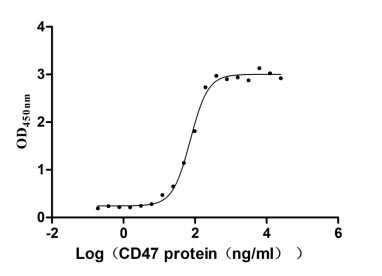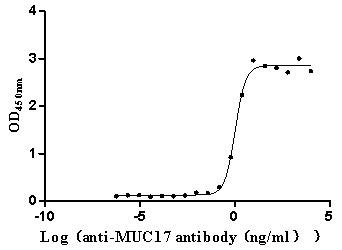Recombinant Human Insulin-like 3 (INSL3), partial
-
中文名称:人INSL3重组蛋白
-
货号:CSB-YP011747HU
-
规格:
-
来源:Yeast
-
其他:
-
中文名称:人INSL3重组蛋白
-
货号:CSB-EP011747HU
-
规格:
-
来源:E.coli
-
其他:
-
中文名称:人INSL3重组蛋白
-
货号:CSB-EP011747HU-B
-
规格:
-
来源:E.coli
-
共轭:Avi-tag Biotinylated
E. coli biotin ligase (BirA) is highly specific in covalently attaching biotin to the 15 amino acid AviTag peptide. This recombinant protein was biotinylated in vivo by AviTag-BirA technology, which method is BriA catalyzes amide linkage between the biotin and the specific lysine of the AviTag.
-
其他:
-
中文名称:人INSL3重组蛋白
-
货号:CSB-BP011747HU
-
规格:
-
来源:Baculovirus
-
其他:
-
中文名称:人INSL3重组蛋白
-
货号:CSB-MP011747HU
-
规格:
-
来源:Mammalian cell
-
其他:
产品详情
-
纯度:>85% (SDS-PAGE)
-
基因名:INSL3
-
Uniprot No.:
-
别名:INSL 3; INSL3; INSL3_HUMAN; Insulin like 3; insulin like peptide, Leydig cell-specific; insulin-like 3 (Leydig cell); Insulin-like 3 A chain; Ley IL; Ley-I-L; leydig insulin -like hormone; Leydig insulin like peptide; Leydig insulin-like peptide; prepro-INSL3; Relaxin like factor ; Relaxin-like factor; relaxin-like factor b; RLF; RLNL
-
种属:Homo sapiens (Human)
-
蛋白长度:Partial
-
表达区域:21-55
-
氨基酸序列LGPAPTPEMR EKLCGHHFVR ALVRVCGGPR WSTEA
-
蛋白标签:Tag type will be determined during the manufacturing process.
The tag type will be determined during production process. If you have specified tag type, please tell us and we will develop the specified tag preferentially. -
产品提供形式:Lyophilized powder
Note: We will preferentially ship the format that we have in stock, however, if you have any special requirement for the format, please remark your requirement when placing the order, we will prepare according to your demand. -
复溶:We recommend that this vial be briefly centrifuged prior to opening to bring the contents to the bottom. Please reconstitute protein in deionized sterile water to a concentration of 0.1-1.0 mg/mL.We recommend to add 5-50% of glycerol (final concentration) and aliquot for long-term storage at -20℃/-80℃. Our default final concentration of glycerol is 50%. Customers could use it as reference.
-
储存条件:Store at -20°C/-80°C upon receipt, aliquoting is necessary for mutiple use. Avoid repeated freeze-thaw cycles.
-
保质期:The shelf life is related to many factors, storage state, buffer ingredients, storage temperature and the stability of the protein itself.
Generally, the shelf life of liquid form is 6 months at -20°C/-80°C. The shelf life of lyophilized form is 12 months at -20°C/-80°C. -
货期:Delivery time may differ from different purchasing way or location, please kindly consult your local distributors for specific delivery time.Note: All of our proteins are default shipped with normal blue ice packs, if you request to ship with dry ice, please communicate with us in advance and extra fees will be charged.
-
注意事项:Repeated freezing and thawing is not recommended. Store working aliquots at 4°C for up to one week.
-
Datasheet :Please contact us to get it.
相关产品
靶点详情
-
功能:Seems to play a role in testicular function. May be a trophic hormone with a role in testicular descent in fetal life. Is a ligand for LGR8 receptor.
-
基因功能参考文献:
- Variants of the INSL3 gene are prevalent in patients with testicular torsion instead of healthy subjects. PMID: 29785651
- The strong positive correlation between INSL3, and high ovarian androgens levels in all polycystic ovary syndrome women, which appeared clearly in undescended polycystic ovaries could support the proposed syndrome hypothesis between those abnormal findings. PMID: 29254383
- KLF6-mediated activation of the human INSL3 promoter required an intact KLF element as well as Leydig/Sertoli-enriched factors. KLF6 transcriptionally cooperates with NUR77 and SF1. our results identify KLF6 as a regulator of human INSL3 transcription. PMID: 26874000
- The INSL3 G178A polymorphism was not significantly associated with spermatozoa or no spermatozoa in the testes of males with a history of bilateral cryptorchidism. I The evidence suggests that mutations of INSL3 may not directly contribute to the damage of spermatogenesis in patients with bilateral cryptorchidism history. PMID: 26840636
- hINSL3 seems to recruit Aund spermatogonia into differentiation, potentially mediating an Fsh effect on spermatogenesis. PMID: 26077926
- Healthy eumenorrheic late adolescent females with sporadic anovulation display higher INSL3 blood concentration. PMID: 26579638
- rs6523 polymorphism and AGAG haplotype of INSL3 showed significant association with increased risk of polycystic ovary syndrome. PMID: 26625974
- INSL3 in girls is a unique and specific marker of theca cells surrounding antral follicles. PMID: 25516081
- Three common INSL3 gene polymorphisms (27G>A, 126G>A, 178G>A) unrelated to any particular phenotype of testicular maldescent (TMD) were detected both in patients and controls, indicating that INSL3 gene mutations are not a common cause of TMD. PMID: 25728210
- DLK1, INSL3 and COUP-TFII expression changes during normal development and is linked to different stages of Leydig Cell differentiation. PMID: 24908673
- low INSL3 concentration is related to the pathogenesis behind an unfavourable change in body composition and bone metabolism among Klinefelter syndrome patients PMID: 24659579
- The aim of this study was to assess plasma INSL3 in patients with osteoporosis and Klinefelter's Syndrome compared to healthy males. PMID: 24640568
- INSL3 is as sensitive a marker as T for the evaluation of altered Leydig cell function in congenital hypogonadotropic hypogonadism/Kallmann syndrome patients. PMID: 24243640
- INSL3 and AMH levels are significantly correlated with each other in women with PCOS, and they are significantly increased, particularly in the presence of amenorrhea and oligomenorrhea. PMID: 23928669
- Findings suggest a novel and gender-specific role for INSL3 and cognate receptor RXFP2 signaling in ocular surface homeostasis. PMID: 23539510
- Most Prader-Willi syndrome males have normal INSL3 levels. PMID: 23150680
- In the meta-analysis, INSL3 rs10421916 and rs11088680 had both a 0.8-fold decreased odds ratio for gastric cancer. PMID: 23028900
- Cystin A11-B10 serves as an insulator between the two ports, whereas the amide functionality disturbs the signal transmission complex likely due to changes in polarity. PMID: 22574850
- Data suggest that insulin-like factor 3 is related to functional ovarian hyperandrogenism in women with polycystic ovary syndrome. PMID: 21586896
- study demonstrates that the INSL3/RXFP2 system is involved in bone metabolism by acting on the MAPK cascade and stimulating transcription of important genes of osteoblast maturation/differentiation and osteoclastogenesis PMID: 22216350
- Data show that synthetic parallel dimer of the B-chain of INSL3 is a potent inhibitor of the native peptide's binding to its receptor, RXFP2. PMID: 20560146
- The current knowledge of INSL3, its involvement in testicular descent and germ cell survival, verifies that this Leydig cell hormone is an important player in testicular physiology[review] PMID: 20550598
- High INSL3 is associated with testicular Leydig cell tumors. PMID: 19110449
- investigation of INSL3 structural requirements (i.e., intra-A-chain disulfide bonds) for binding to & activation of RXFP2 PMID: 20570702
- INSL3 is a powerful and multifunctional promoter of tumor growth and angiogenesis in human thyroid cancer cell xenografts. INSL3 actions involve RXFP2 activation and the secretion of S100A4 and (pro-)cathepsin-L PMID: 19950223
- Results describe the in vitro degradation of insulin-like peptide 3 by insulin-degrading enzyme. PMID: 20082125
- Analogues of INSL3 with higher alpha-helicity had higher receptor binding affinity. PMID: 19067106
- A novel mutation in this protein is found in patients with cryptorchidism. PMID: 12601553
- differentially expressed in hyperplastic and neoplastic thyrocytes, and in various thyroid diseases PMID: 12684664
- the only clinical consequence of alterations of the INSL3-LGR8 system seems to be failure of the testis to normally descend in the scrotum during embryonic development, without affecting the spermatogenic and endocrine components of the testis itself PMID: 12970298
- Analysis of men treated with different combinations of hormones of the hypothalamus-pituitary-testis axis suggests that the production of INSL3 is related to LH in a manner similar to that of the LH-testosterone axis. PMID: 15579743
- Although a common polymorphism was identified in the INSL3 gene, no mutations were observed. Lack of association between genetic factors necessary for correct testicular descent and anorchia. PMID: 15579790
- LGR8 signal is activated by the relaxin-like factor PMID: 15708846
- Even testosterone and INSL3 are both dependent on lutropin, thesse two Leydig cell hormones are regulated differently. PMID: 15755855
- relaxin-like hormones appear to be present early during C-cell hyperplasia and potentially functional relaxin/INSL3 ligand-receptor systems are present in human medullary thyroid carcinoma tissues and cell lines PMID: 15956746
- Analysis of men treated with different combinations of hormones of the hypothalamus-pituitary-testis axis suggests that the production of INSL3 is related to the luteinizing hormone PMID: 15956751
- Strongest INSL3 expression was detected in the basal epithelial cell compartment of the prostate epithelial cells, while weaker mRNA expression and immunoreactive production were observed in secretory epithelial cells. PMID: 16010410
- INSL3 is not sensitive to gonadotropin stimulation in normal men, but declines markedly in response to gonadotropin deprivation. PMID: 16394084
- Thus, the human INSL3 promoter constitutes a novel target for the orphan nuclear receptor Nur77. PMID: 16467267
- Results showed a significant association of INSL3 gene mutations in men presenting one or more signs of testicular dysgenesis syndrome. PMID: 16687567
- INSL3 was found to adopt a characteristic relaxin/insulin-like fold in solution but is a highly dynamic molecule. The four termini of this two-chain peptide are disordered, and additional conformational exchange is evident in the molecular core. PMID: 16867980
- The data show that INSL3 is an independent measure of Leydig cell function (quality and number), which appears to be independent of acute control via the HPG axis. PMID: 17014531
- The results, in conjunction with the previous data, suggest that mutations of INSL3 and LGR8/GREAT remain rare, and that the Thr/Thr genotype of Ala60Thr polymorphism in INSL3 may constitute a susceptibility factor for the development of cryptorchidism. PMID: 17028442
- INSL3 blood levels may be higher in men with persistent spermatogenesis during treatment with male hormonal contraceptives. PMID: 17314233
- INSL3 could be considered a new circulating hormone related to LH-dependent ovarian hyperandrogenism, particularly in normal-weight polycystic ovary women PMID: 17356050
- Mutations involving the insulin-like factor 3 gene may contribute to other anomalies of male genital development, such as micropenis. PMID: 17437853
- predicted the complete INSL3/LGR8 primary binding site, including interactions between INSL3 His-B12 and LGR8 Trp-177, INSL3 Val-B19 and LGR8 Ile-179, and INSL3 Arg-B20 with LGR8 Asp-181 and Glu-229 PMID: 17473281
- Higher blood levels may be indicative of ovarian cancer. PMID: 17549672
- The common INSL3 G178A polymorphism was not statistically significantly associated with male infertility. PMID: 17559848
- In boys, early postnatal INSL3 is markedly higher as compared with later childhood, presumably because it is stimulated by the transient postnatal LH peak PMID: 17666478
显示更多
收起更多
-
相关疾病:Cryptorchidism (CRYPTO)
-
亚细胞定位:Secreted.
-
蛋白家族:Insulin family
-
组织特异性:Expressed in prenatal and postnatal Leydig cells. Found as well in the corpus luteum, trophoblast, fetal membranes and breast.
-
数据库链接:
HGNC: 6086
OMIM: 146738
KEGG: hsa:3640
STRING: 9606.ENSP00000321724
UniGene: Hs.37062
Most popular with customers
-
Recombinant Human Leukocyte surface antigen CD47 (CD47), partial (Active)
Express system: Mammalian cell
Species: Homo sapiens (Human)
-
Recombinant Human Programmed cell death protein 1 (PDCD1), partial (Active)
Express system: Mammalian cell
Species: Homo sapiens (Human)
-
Recombinant Human Signal transducer CD24 (CD24)-Nanoparticle (Active)
Express system: Mammalian cell
Species: Homo sapiens (Human)
-
Recombinant Human Zymogen granule protein 16 homolog B (ZG16B) (Active)
Express system: Mammalian cell
Species: Homo sapiens (Human)
-
Recombinant Human Mucin-17 (MUC17), partial (Active)
Express system: Mammalian cell
Species: Homo sapiens (Human)
-
Recombinant Human Carcinoembryonic antigen-related cell adhesion molecule 6 (CEACAM6) (Active)
Express system: Mammalian cell
Species: Homo sapiens (Human)
-
Recombinant Mouse Cell adhesion molecule 1 (Cadm1), partial (Active)
Express system: Mammalian cell
Species: Mus musculus (Mouse)
-
Recombinant Human CUB domain-containing protein 1 (CDCP1), partial (Active)
Express system: Mammalian cell
Species: Homo sapiens (Human)




















